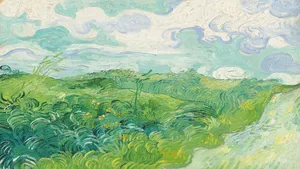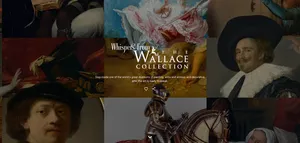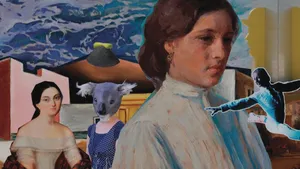Meet Mali - home of manuscripts, music and magic
Timbuktu is a city fabled to exist at the edge of the world, where the southern stretches of the Sahara desert end and a world of rich scholarly tradition, architectural wonder and abundant artistic creativity begins. In reality, it’s located in the West African country of Mali, a place filled to the brim with the kind of unmatched cultural richness that comes from traditions and influences from across the Sahara and Sahel melding together in harmony for centuries – all of which “Mali Magic” on Google Arts & Culture will share with you today.
Though popularly known as the historic home of Mansa Musa (the richest man in the world), the true magic of Mali doesn’t stem from these fractured fables so much as from the pillars that define its culture — its manuscripts, music, monuments and modern art — and their unbelievable resilience to human and environmental threats, thanks to the people’s quest to preserve their heritage.
M is for Mali
Mali’s story has often been told with attention to the violence and political unrest the nation has experienced, namely the 2012 coup and subsequent ten-month Jihadist occupation, which resulted in the destruction of many mausoleums, mosques and monuments, the burning of ancient manuscripts, and the breaking of instruments and cancelling of festivals to silence the music traditions that defined its culture. But the Malian people did not let their culture become a victim of destruction. From saving the ancient manuscripts that families protected for years from total destruction, to the contemporary artistic movements that are rising from times of turmoil, the resilience of Mali’s people and culture has been proven. Read more about their effort to preserve and digitize their libraries here.
Mali Magic on Google Arts & Culture shines a light on these heroic stories of resilience and presents Mali’s monuments, manuscripts, music and modern arts in a digital collection of sound and story like no other.
Watch the music video bringing together contemporary Malian musicians from all over Mali, covering a song by the iconic Malian singer Ali Farka Touré.
On an exclusive album produced in and telling the story of Mali, Grammy-award nominee Fatoumata Diawara sings about her country’s legacy and hopes for the future.
Delicate and decorative folio containing important teachings both religious and secular, are amongst the collections that families preserved in their homes for centuries before the evacuation from Timbuktu.
A 3D model of the largest adobe structure in the world. The Grand Mosque of Djenne, that goes as high as 20 meters, and can hold up to a 1000 people.
One of the most influential artists on Africa’s contemporary art scene, Abdoulaye Konaté renders vibrant wall tapestries in Malian cotton, inspired by African tradition and culture while raising awareness for pressing political, social and environmental issues within and beyond Mali.
M is for Manuscripts
Long before the European Renaissance, the Malian city of Timbuktu — which at one point was home to a community of scholars that made up a quarter of its whole population — gave birth to an abundance of learning in the fields of morality, politics, astronomy, literature and more surprising topics like black magic and sex advice. This work was captured in thousands of precious manuscripts. These pages have redefined our understanding of African history; Dr. Abdel Kader Haidara, the ‘badass librarian’ known for smuggling the manuscripts out of Timbuktu when their safety was at risk, has said that "they have said that in Africa there is no written history. It’s been said that all the history of Africa is oral. We have more than 400,000 manuscripts here written uniquely by the hands of the hands of Africans. They will see this and say the opposite. It’s a true Renaissance."
Finally, the manuscripts have made their way from family libraries to the world stage: a spectacular collection of 40,000 decorated folios and beautifully scripted Timbuktu manuscripts have been brought to Google Arts & Culture for the world to explore online, and is at the heart of discussions and celebrations to be held in Bamako on March 12th and at the Brooklyn Public Library on March 17th.
Timbuktu’s manuscripts were renowned for their physical beauty as well as their wisdom. Calligraphy styles from the broad slashes of the West African Hausa tradition to the whorls and sweeps of curvaceous North African lettering. There are beautiful, centuries-old Korans with gilding and calligraphy within.
Some of the world’s most important astronomical and astrological developments were made by Islamic scholars, long before Galileo and his telescope; some mapped in the Timbuktu Manuscripts.
Many surprising things can be found in the Timbuktu Manuscripts, from human rights and mathematics to sex tips, black magic or the question if smoking should be banned.
The manuscripts have been preserved over the centuries not by a museum or institution, but by individual families who passed their libraries on through the generations. Because of them, Timbuktu’s written legacy remains for us to marvel at today.
The fragile manuscripts, inked on Italian paper, goat, sheep and even fish skins, were swiftly rescued thanks to individuals who smuggled the pages out of the city by car and boat from under the noses of the Islamist intruders.
M is for Music
From tribal song and dance accompanied by unique traditional instruments, captured on video by Instruments4Africa, to the Festival in the Desert that has hosted the likes of U2 and Mali’s own Fatoumata Diawara, Mali is a place infused with rhythm courtesy of a widespread passion for music. It’s even said that rock ‘n roll and the American blues are deeply rooted in Malian musical and myth-telling traditions.
Today, Mali’s music scene remains strong — musicians from all over Mali have united to cover the iconic Malian artist Ali Farka Touré’s beloved song Houwkuna, Grammy-award nominee Fatoumata Diawara ushers Mali to the front of the world music scene with her brand new EP, Maliba (‘The Great Mali’), and festivals and live concerts are held by the Timbuktu Renaissance and Instruments4Africa to keep soulful sounds and social cohesion alive.
Mali’s musical traditions like the instruments, dances and costumes of the Funeral Ceremony for the Dogon Elders are at risk as the country moves away from a traditional way of life and the inroads of global culture dilute the rich traditions at the nation’s core.
Performing live music is a crucial part of Mali’s musical tradition — streaming just won’t do at traditional ceremonies and events
Famous on the world music scene is Mali’s Festival in the Desert, where the country’s top talent as well as world-class guests such as U2 and Led Zeppelin have played over the years. When the jihadist occupation forced the cancellation of the event, it was instead held ‘in exile’ as Malian musical champions refused to submit to the extremists.
Mali’s long history of musical tradition peaked in the 1960s and 70s, a golden era of sorts in which both the state and private individuals significantly invested in music and culture. The result was a generation of musical bonafides, such as the famous Ali Farka Touré, and a large number of records produced during this period which would define Malian musical history.
During the extremist occupation, the traditions that strengthened Malian communities and identities were targeted - music was banned and instruments were destroyed,, in an attempt to silence the people’s voice and spirit. But Mali’s musicians continued to share their heritage and talent with the world whenever and however they could, so that Mali's musical tradition could live on.
M is for Monuments
A third layer of Mali’s unique cultural landscape is made up of its mosques, mausoleums and monuments. These structures are not just iterations of historic mud architectural styles and commemorations of past events; they are kept alive by the communities who have maintained them for centuries and the efforts to restore them after their recent destruction by those attempting to shake the foundations of Malian culture and identity.
From political unrest and the end of tourism to globalization and pollution, several factors threaten Mali’s monuments and its culture at large. Exploring the Great Mosque of Djenne in 3D, or the first ever Street View of Mali’s mosques and monuments, it’s clear that this built heritage is worth protecting and preserving for generations to come.
In the first ever Street View of Mali’s endangered mosques and mausoleums, users can tour and learn the secrets of the Djinguereber Mosque: above the main door, there’s said to be a barely-legible inscription of the name Mansa Moussa, the richest man in history.
The incredible festival to replaster the Great Mosque of Djenne takes place every year by the local community, who use the opportunity to work together to preserve and celebrate their heritage. Despite racing to finish the neighborhood’s portion of work to win first prize, it is said that there has never been an injury during the festival.
Following the destruction of mausoleums and sites of ancestral heritage that were targeted during conflict, UNESCO collaborated with local masons to restore and reconstruct these built heritage sites.
M is for Modern Art
Carrying out Mali’s lasting legacy of creativity and vibrant culture are the country’s incoming generation of contemporary artists. Painters, sculptors, and mixed-media creators reflect the color and chaos that they see in the world around them, entwining Mali’s expressive culture with their own unique perspectives, ambitions and explorations.
Addressing the difficulties and destruction that Mali has endured throughout both recent and colonial history, the country’s art scene might represent a space in which Mali’s past can be processed and, through culture and creativity, a future can be rebuilt.
“The day we admit that we lost everything for the profit of others; that day we can truly begin to rediscover ourselves,” says Malian contemporary artist Amadou Sanogo.
From the early days of his career, Amadou Opa Bathily has engaged in ‘art recovery’, working with recycled metal to make sculpture. Bathily's paintings continue to be identified by these hard materials which he sculpts to his canvas. His works and materials are both flexible and enduring.
Drawing inspiration from the mountainous areas, stones, and boulders of the rocky escarpments of Dogon country, Souleymane Guindo’s works connect him to the culturally rich area in central Mali where he has his familial and ethnic roots.
Artist Ange Dakouo’s current work is inspired by protective amulets known as gris gris that are attached to a child’s wrist or neck at birth or sewn into the outfits of traditional hunters in West Africa. He creates his own woven gris gris, which traditionally are thought to ward off evil djinn, bad luck, and even ammunition rounds of enemy fire.
The works of Dramane Toloba are eco-responsible and based on the recovery of trash disposed by people into nature. His creations are inspired by the wastefulness of consumer society, contrasted with the natural world of traditional rural society, gratitude, and the constant battle of scarcity.
Discover more on g.co/MaliMagic online or through the Google Arts & Culture mobile app on iOS and Android.






